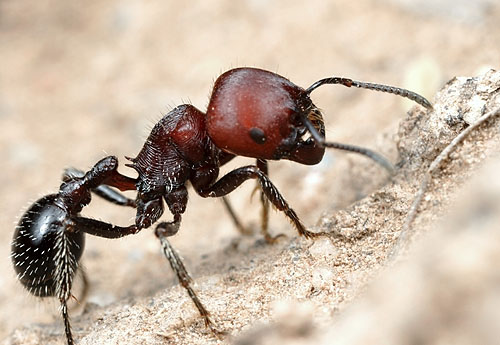
Pogonomyrmex micans, Santiago del Estero, Argentina
Ants of the genus Pogonomyrmex ("Pogos") are known to myrmecologists as the classic harvester ants of North American deserts. They are conspicuous insects, the most noticeable of the desert ants, and something of a model organism for studies of ecology. Numerous scientific papers on pogos are published each year, and one species- Pogonomyrmex californicus- is mailed to school classrooms around the country to populate those plastic ant farms.
It's easy to forget amidst the celebrated riches of North American pogos that South America also holds a great number of species. In fact, it is likely that the genus first arose in South America; the southern pogos display a greater variety of morphologies and inhabit a broader swath of habitats.
Yet, these austral pogos are largely ignored. Consider the results of a quick google search:

Searches for some common Nearctic species return an order of magnitude more web pages than equivalent searches on some common Neotropical species. This is a shame, for the southern pogos form both an evolutionary backdrop for understanding our northern ants and are plenty interesting in their own right.
Anyway. Here are some recent photos of the neglected southern Pogonomyrmex.

Pogonomyrmex cunicularius, Entre Rios, Argentina

Pogonomyrmex micans, Santiago del Estero, Argentina

Pogonomyrmex rastratus, Tucumán, Argentina

I once had the pleasure of looking at some of Bob Johnson's collections of this genus from Argentina. There are some real beauties in that fauna, suggested by your pictures. And there are, by North American standards, extraordinary biological features such as polygyny and barely recognizable ergatoid queens in some of them. He is in the process of preparing description of a number of new ones, too.
this masterpiece is really something that is worth remembering..very nice shots!
I love harvester ants! I wished they around my place. Dang Argentine ants!
A sample of the article is translated in french here :
http://fourmis-exotiques.fr/viewtopic.php?pid=1811#p1811
if it's a problem, we can delete this topic